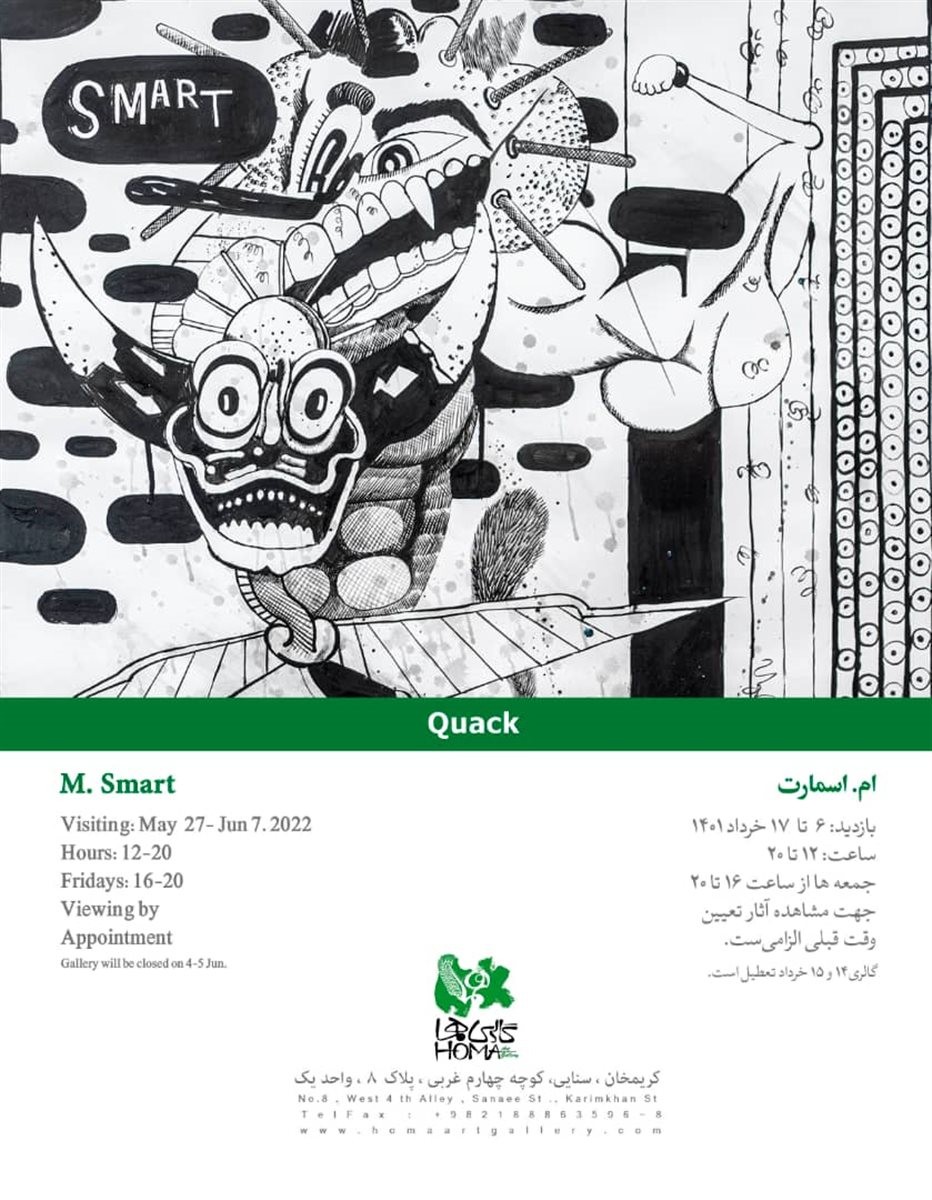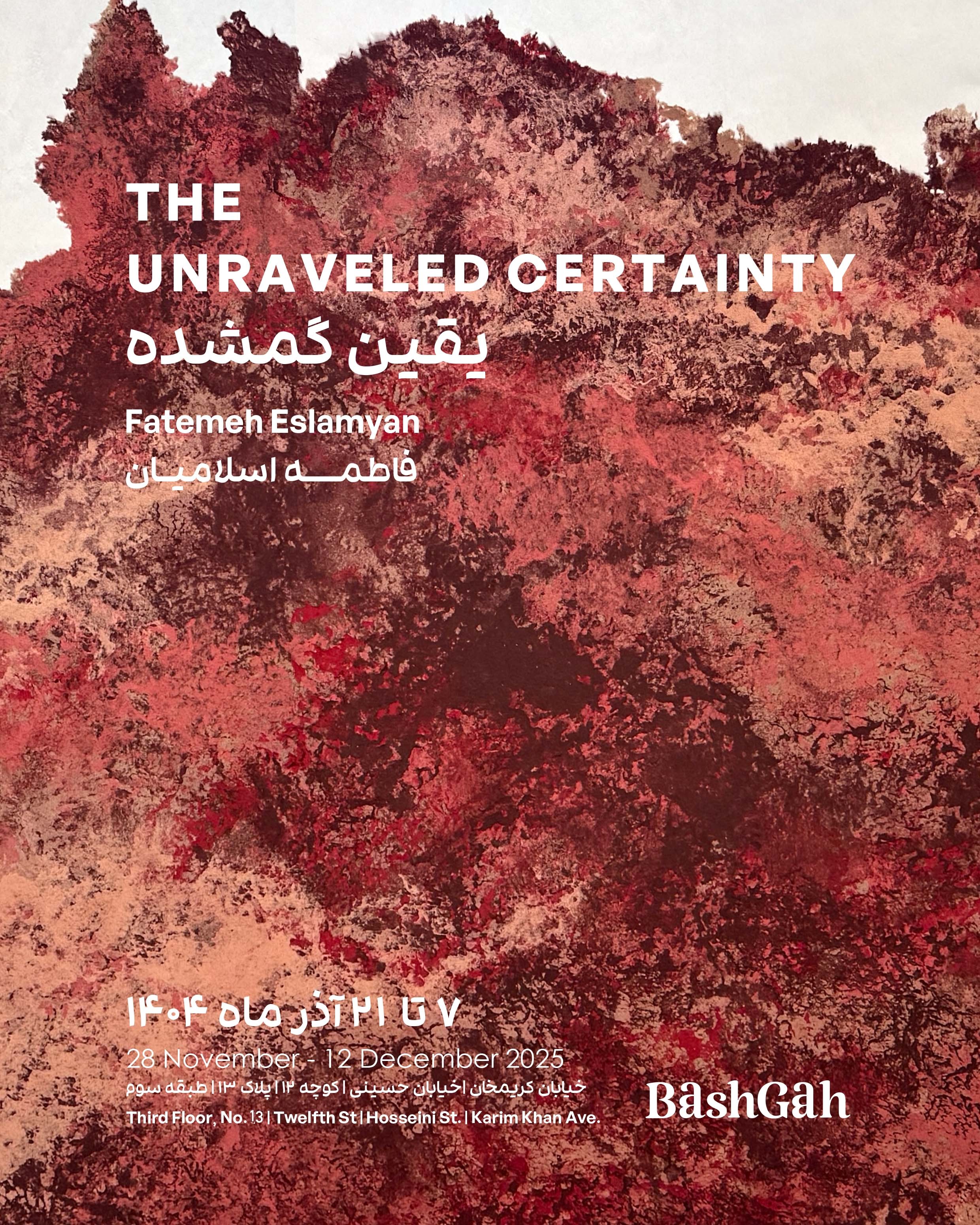Tehran,
8, West 4th Alley Sanaee St., Karimkhan Zand St.
27 May 2022 - 7 June 2022
As an artist M. Smart is primarily a painter, but he also draws and makes sculptures. He is among a
young generation of artists who use a universal language and sense of humor to depict subjects related
to day-to-day contemporary life, more boldly and with more freedom compared to their predecessors.
They create art that does not rely on their own specific geographical context, and is instead on par with
the art being created by their peers in other parts of the world. This results in aesthetics, form, thought,
consciousness, and a visual experience and understanding that is different from what has previously
existed in the history of Iranian art, and which is even rare in Iranian contemporary visual arts.
Internal expression and rebellion; the audacity of experimentation and the combination of graphic
design language with comics and pop art; surreal and neo-surreal spaces combined with a cartoon
world - inspired by Walt Disney, etc. - illuminated by bright, neon, digital colors; painterly activism;
imagination and ideation and a humorous playfulness; these are the characteristics of this artist that have
placed him among the frontrunners of his generation.
The flat, two-dimensional spaces, and use of bold colors in the hidden layers of his work are also
reminiscent of traditional Iranian paintings.
In his energetic compositions Smart easily combines buildings, figures, sports fields, animals,
imaginary or deformed creatures, metropolitan landscapes, flowers and plants, and colorful
active forms.
The other interesting features of this artist’s work are their technical ability and the connection and
contrast between depth and surface, structure and deconstruction, relatively precise details compared to
free surfaces, and behaviorism without the elimination of meaning and spontaneity.
At first glance his work may seem unrestrained, presenting the viewer with unfamiliar spaces. His
compositions may seem chaotic and his ideas placed within them without any consideration of
proportions. But with some deliberation one will find that there is a solid and humorous idea within
the deeper and hidden layers of this chaotic structure and the rotation and fast dynamic movement of
images, spaces, and fields of color. It is this idea that dominates the entire space, and with colors that
are used with utmost energy and movement, integrates and balances the work, giving cohesion to its
heterogeneous and contradictory elements; ultimately making it a coherent whole. The dominant aspect
of many of this artist’s works is a humorous playfulness with objects and visual elements. But it must be
noted that the humor in Smart’s work is neither imposed from the outside, nor a humorous political or
psychological critique. The use of humor as a visual element allows him to maintain his personal world
and his distance from a value system that surrounds him.
Perhaps this saying by Albert Oehlen best describes Smart and his art, “An artist’s work must always
include questions, aggression, and humor; an artist must get angry and create a riot in order to give form
to his work.”
Ali Nassir
young generation of artists who use a universal language and sense of humor to depict subjects related
to day-to-day contemporary life, more boldly and with more freedom compared to their predecessors.
They create art that does not rely on their own specific geographical context, and is instead on par with
the art being created by their peers in other parts of the world. This results in aesthetics, form, thought,
consciousness, and a visual experience and understanding that is different from what has previously
existed in the history of Iranian art, and which is even rare in Iranian contemporary visual arts.
Internal expression and rebellion; the audacity of experimentation and the combination of graphic
design language with comics and pop art; surreal and neo-surreal spaces combined with a cartoon
world - inspired by Walt Disney, etc. - illuminated by bright, neon, digital colors; painterly activism;
imagination and ideation and a humorous playfulness; these are the characteristics of this artist that have
placed him among the frontrunners of his generation.
The flat, two-dimensional spaces, and use of bold colors in the hidden layers of his work are also
reminiscent of traditional Iranian paintings.
In his energetic compositions Smart easily combines buildings, figures, sports fields, animals,
imaginary or deformed creatures, metropolitan landscapes, flowers and plants, and colorful
active forms.
The other interesting features of this artist’s work are their technical ability and the connection and
contrast between depth and surface, structure and deconstruction, relatively precise details compared to
free surfaces, and behaviorism without the elimination of meaning and spontaneity.
At first glance his work may seem unrestrained, presenting the viewer with unfamiliar spaces. His
compositions may seem chaotic and his ideas placed within them without any consideration of
proportions. But with some deliberation one will find that there is a solid and humorous idea within
the deeper and hidden layers of this chaotic structure and the rotation and fast dynamic movement of
images, spaces, and fields of color. It is this idea that dominates the entire space, and with colors that
are used with utmost energy and movement, integrates and balances the work, giving cohesion to its
heterogeneous and contradictory elements; ultimately making it a coherent whole. The dominant aspect
of many of this artist’s works is a humorous playfulness with objects and visual elements. But it must be
noted that the humor in Smart’s work is neither imposed from the outside, nor a humorous political or
psychological critique. The use of humor as a visual element allows him to maintain his personal world
and his distance from a value system that surrounds him.
Perhaps this saying by Albert Oehlen best describes Smart and his art, “An artist’s work must always
include questions, aggression, and humor; an artist must get angry and create a riot in order to give form
to his work.”
Ali Nassir

Artists
Available Nearby Exhibitions
The Unraveled Certainty
Tehran
28 November 2025 - 12 December 2025
580 Nanometers / Yellow
Tehran
28 November 2025 - 8 December 2025

